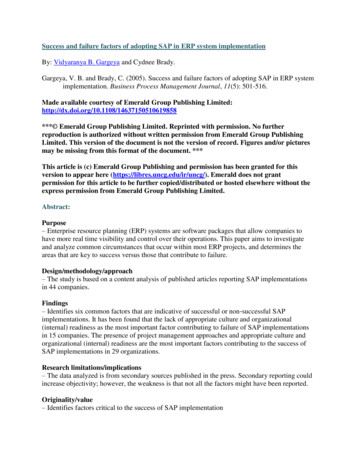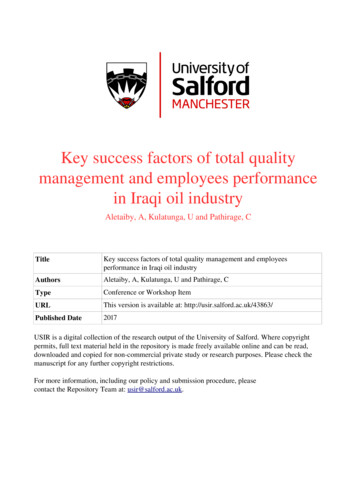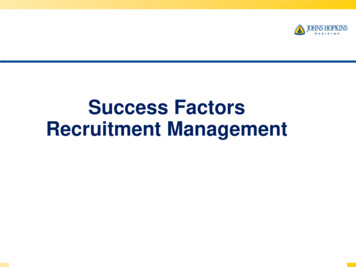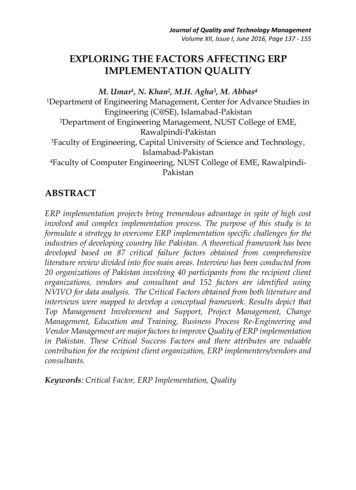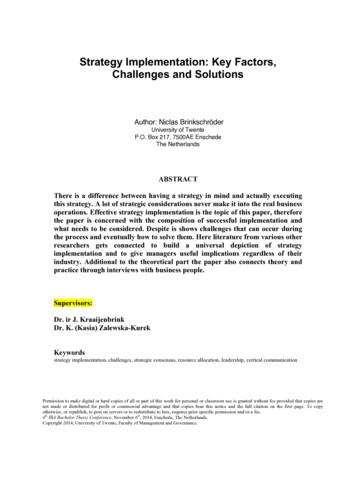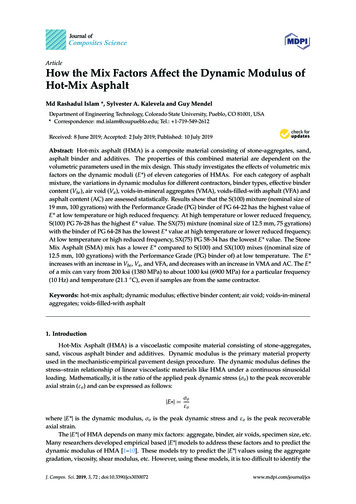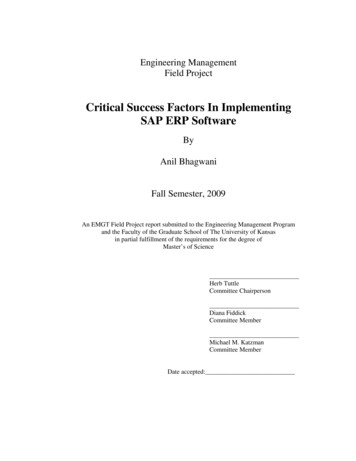
Transcription
Engineering ManagementField ProjectCritical Success Factors In ImplementingSAP ERP SoftwareByAnil BhagwaniFall Semester, 2009An EMGT Field Project report submitted to the Engineering Management Programand the Faculty of the Graduate School of The University of Kansasin partial fulfillment of the requirements for the degree ofMaster’s of ScienceHerb TuttleCommittee ChairpersonDiana FiddickCommittee MemberMichael M. KatzmanCommittee MemberDate accepted:
ACKNOWLEDGEMENTSI would like to thank Herb Tuttle, my EMGT program advisor and the chairperson of theadvisory committee for his guidance and support without which this work would have notbeen possible. I would like to thank my committee members Diana Fiddick and MichaelKatzman for their valuable feedback and guidance.I would like to sincerely acknowledge the opportunity given by Rhett Tindall – CIOAMP/NBRC group to work and gain real time experience in IT field. I am thankful toNisha Bhagchandani IT Manager – AMP/NBRC group for her valuable feedbackthroughout the project.Special thanks go to my employer’s Corning Frequency Control and LegacyTechnologies for financially supporting my Engineering Management studies atUniversity of Kansas.EMGT Field Project – Anil BhagwaniUniversity of KansasPage 2
TABLE OF CONTENTSACKNOWLEDGEMENTS . 2EXECUTIVE SUMMARY . 5ACRONYMS . 6INTRODUCTION . 7LITERATURE REVIEW . 9ASAP METHODOLOGY . 9CRITICAL SUCCESS FACTORS . 13Organizational Perspective . 13Technological Perspective . 18CASE STUDIES . 19Hershey Food Corporation . 19Levi Strauss & Company . 20Fox Meyer Drugs . 21Los Angeles Unified School District . 22Waste Management Incorporated . 23Hewlett-Packard Company . 25Shane Corporation . 26Select Comfort Corporation . 27Whirlpool Corporation . 27American LaFrance . 28Vienna City Administration . 29Air Products and Chemicals Incorporated . 30Border State Industries . 31Air France . 33China Everbright Bank . 34Finnish Food Processing Company . 34Tata Steel . 35Telefonica . 36Taikang Life Insurance . 36Wyeth . 37RESULTS AND DISCUSSIONS . 39SUGGESTION FOR ADDITIONAL WORK . 45EMGT Field Project – Anil BhagwaniUniversity of KansasPage 3
REFERENCES . 46BIBLIOGRAPHY . 50EMGT Field Project – Anil BhagwaniUniversity of KansasPage 4
EXECUTIVE SUMMARYThis project gives an overview of the Systems Applications and Products in DataProcessing (SAP) Enterprise Resource Planning (ERP) implementation roadmap andtools that make up a complete implementation method to allow any organization to planand execute the implementation of SAP ERP software. The ASAP (Accelerated SAP)implementation methodology is used as the SAP implementation reference model in thisstudy as most of the companies implementing SAP use ASAP methodology.In a survey of software implementation effectiveness, more than 30% of projects wereperceived to have failed because of a lack of effective project planning, while 10% wereperceived to have failed because of technology-driven causes1. Critical success factorsand reasons for SAP ERP implementation success and failures are discussed in thisproject. Content analysis of articles reporting SAP implementations in twenty companiesfrom all over the world have been done. Ten of these companies had a successful SAPERP implementation and the other ten were failures. Common critical success factorshave been identified for successful SAP ERP implementations based on the contentanalysis. Sustained executive management support and their ownership of theimplementation, project team composition and good project management especiallypertaining to process design, testing and training of the end users are the most importantfactors contributing to the success of SAP implementations in most organizations. Thelack of sustained management support / contribution and user involvement / training and testingseems to be the most important factors contributing to the failure of SAP implementationsin most organizations.EMGT Field Project – Anil BhagwaniUniversity of KansasPage 5
ACRONYMSSAPSystems Applications and Products in Data ProcessingSAP AG Supplier and patent holder for SAP processERPEnterprise Resource PlanningASAP Accelerated SAPCSFCritical Success FactorsCRM Customer Relationship ManagementSCM Supply Chain ManagementBIBusiness IntelligencePLM Product Lifecycle ManagementROIReturn on InvestmentOCM Organizational Change ManagementBPEBusiness Process EngineeringSLAService Level AgreementSKUStock Keeping UnitMRO Maintenance Repair and OperationalEMGT Field Project – Anil BhagwaniUniversity of KansasPage 6
INTRODUCTIONFor a long time, companies struggled with extremely long project timelines in order todevelop information systems that met their specific requirements. Companies had todevelop a custom code which was tedious process requiring many programmers as wellas significant end-user involvement. Moreover, after implementation most of theseprogrammers needed to be retained for the maintenance of custom programming. Projecttimelines were dragged out because often business owners didn’t know what they wanteduntil they saw it (“analysis paralysis”) 2. Many companies had departmentalized systems,which did not share information and thus became the “information silos” within anorganization. This resulted in data discrepancies which resulted in companies taking along time to close the books for quarter and year-end reporting. These unconnected andmultiple systems also created a need for many distinct interfaces between systems thatwere not designed to talk with each other.In order to eliminate these problems, a new breed of software systems, called EnterpriseResource Planning (ERP), was created. These systems provide a single source of datawith designed integration between different functional modules (for example,Accounting, Sales and Distribution, Materials Management, Production planning, etc.).These ERP systems are customized using the table-driven customization method, whichprovide a common set of data source to the whole organization. Due to table settingsinstead of old-fashioned hard-coded program logic, new and changed businessrequirements are rapidly implemented and tested in the system. There are various ERPproducts available today for example from SAP, Oracle, PeopleSoft, JD Edwards,Salesforce.com, Baan, Microsoft, and HP to name a few.SAP AG founded in 1972 is the world’s largest Enterprise Resource Planning (ERP)software with 82,000 customers / 91,500 installations / 12 million users in 120 countriesas of year 2009 1. The SAP system comprises of a number of fully integrated modules: Financials Human Resources Customer Relationship Management Supplier Relationship ManagementEMGT Field Project – Anil BhagwaniUniversity of KansasPage 7
Product Lifecycle Management Supply Chain Management Business IntelligenceThese modules or solutions, as SAP would like to call them, cover virtually every aspectof business management. SAP provides a standard business application software whichreduces the amount of time and money spent on developing and testing all the programs.With hundreds of companies implementing the ERP systems to make their business moreefficient only few are very successful in implementing them. According to a survey doneby Gartner only 60% of companies implementing ERP system claim they got expectedbenefits3. In general an implementation is considered successful if it is done withinbudget and time with meeting all the preset implementation goals as measured by ROI,etc. Also, it is important to understand that delivering an ERP system on time and budgetdoesn’t make sense if no one in the company uses it.In any ERP implementation lots of variables are involved like personnel (business side,technical side, support side, users), implementation partner (for e.g., IBM, Accenture,Cap Gemini, Delloite, Wipro, independent consultants, etc.), software and hardwarevendor (SAP, Oracle, QAD, Peoplesoft, JD Edwards, Baan, Salesforce.com, Baan, HP,Microsoft, etc.), and implementation strategy. With so many things coming together in amatter of few months to a year or so for implementation it is important to know thecritical factors for success and failures of an implementation. This field project is a studyin depth of twenty SAP ERP implementations all across the globe (ten of them successfuland ten of them failures) to determine critical success factors and what needs to be doneand what mistakes to avoid for a successful implementation.EMGT Field Project – Anil BhagwaniUniversity of KansasPage 8
LITERATURE REVIEWLiterature review is divided into three sections: ASAP Methodology, Critical SuccessFactors, and Case Studies.ASAP METHODOLOGYSAP ERP implementation is the group of processes that defines a complete method toimplement SAP software in an organization. The two methodologies used to implementSAP ERP are Conventional and ASAP4. Conventional methodology also known as SAPProcedure Model was widely used initially. In recent past years SAP Procedure Modelhas been overshadowed by the ASAP methodology as implementations with latermethodology are fast and provide flexibility. Most of the companies implementing SAPERP system use ASAP methodology with the exception of very large companies withrevenues in billion dollars. Therefore, in this project ASAP is used as the referencemethodology.In 1996, SAP AG introduced the ASAP (Accelerated SAP) methodology. Thismethodology provides an excellent tool for small and midsize companies to rapidlyimplement SAP and take advantage of its integrated business processes. ASAP providescontent, tools, and expertise based on thousands of successful implementations by SAPand its partners. The ASAP methodology consists of a roadmap that defines the fivephases of SAP implementation process and supports these with a comprehensive projectplan5.ASAP RoadmapPhase 1: Project Preparation - This phase provides initial planning and preparation for theimplementation which includes project plan, project scope, and project teamorganization. In this phase the initiation of the SAP ERP project, which includes theoverall goals, detailed task plans, and processes is formally announced to the company.Main activities in the project preparation phase include a Kickoff meeting and Projectteam standard meeting which include the following tasks: Define project mission statements which reflect
Hershey Food Corporation . perceived to have failed because of a lack of effective project planning, while 10% were perceived to have failed because of technology-driven causes. 1. Critical success factors and reasons for SAP ERP implementation success and failures are discussed in this project. Content analysis of articles reporting SAP implementations in twenty companies from all over the .



